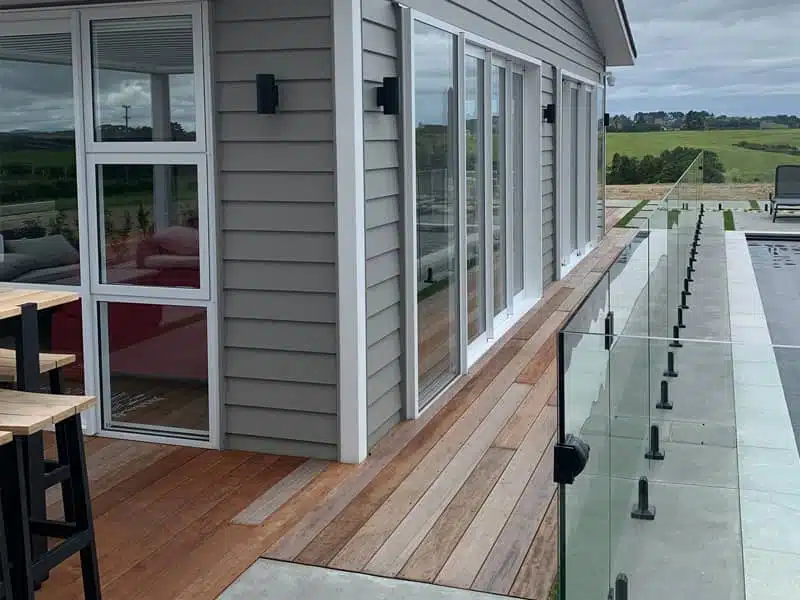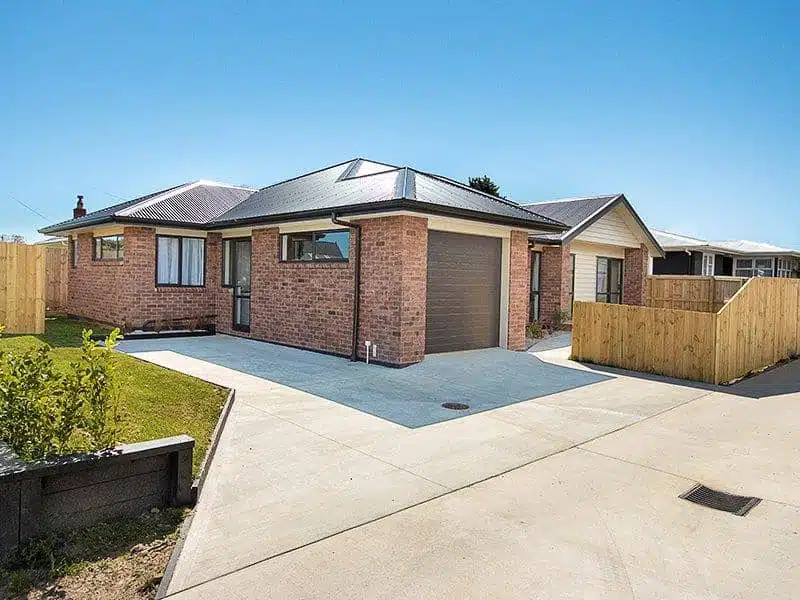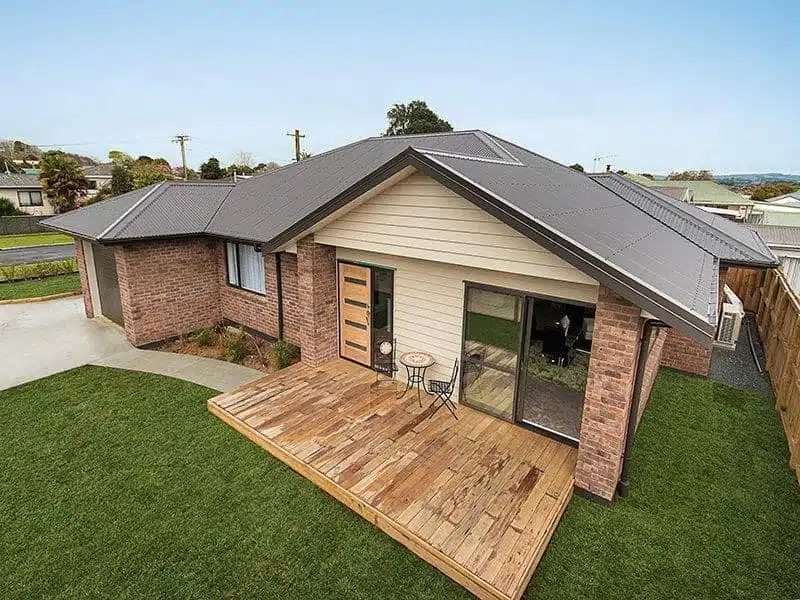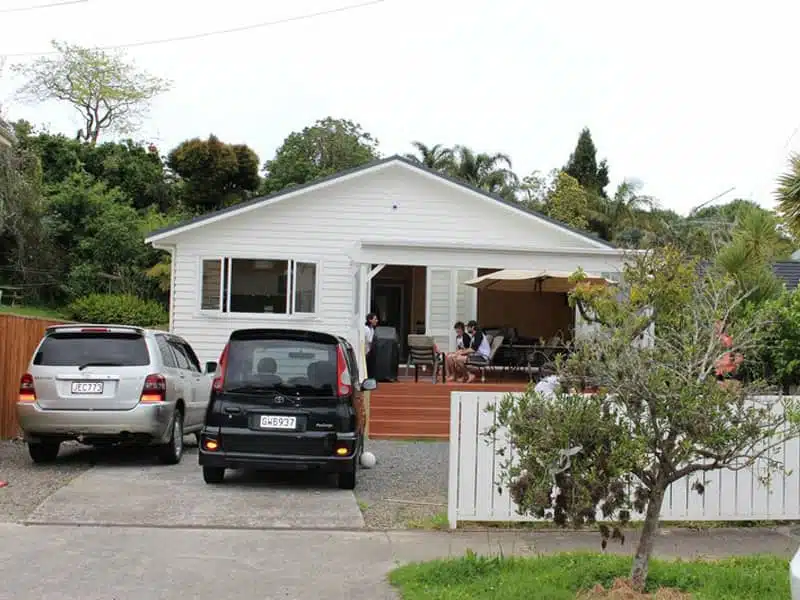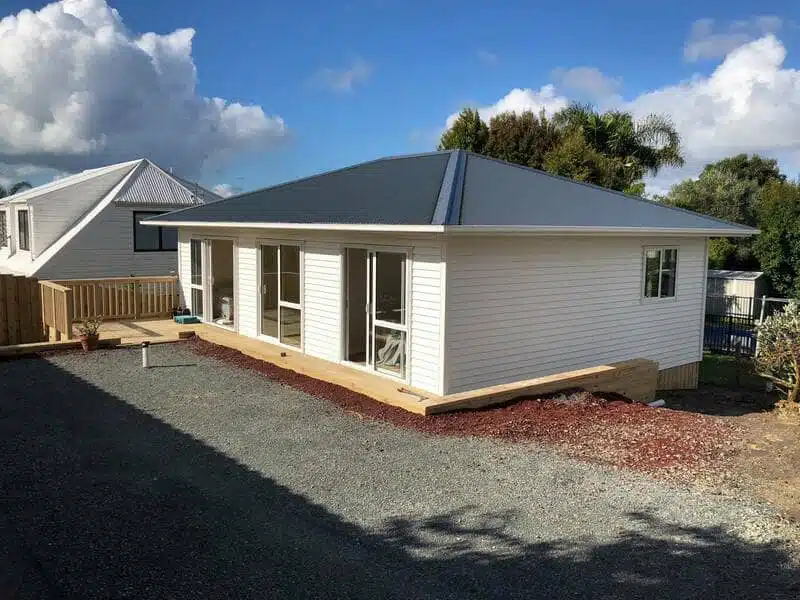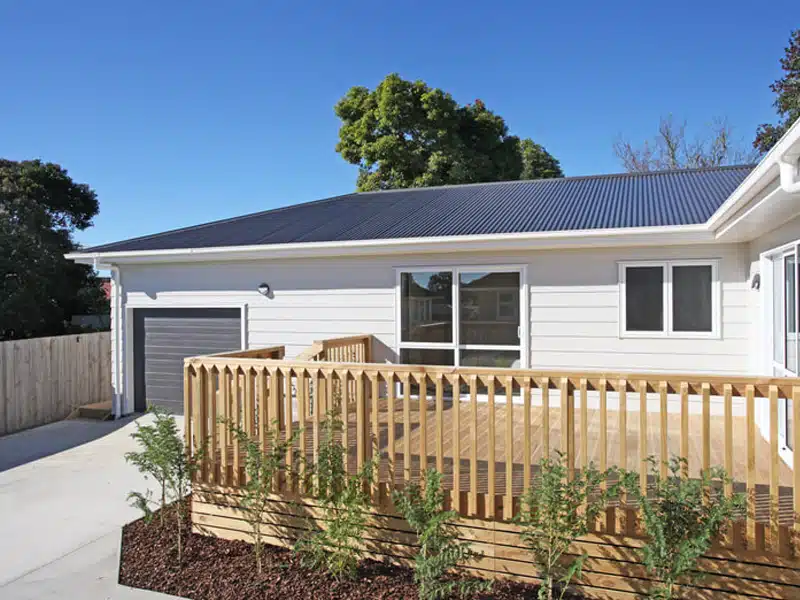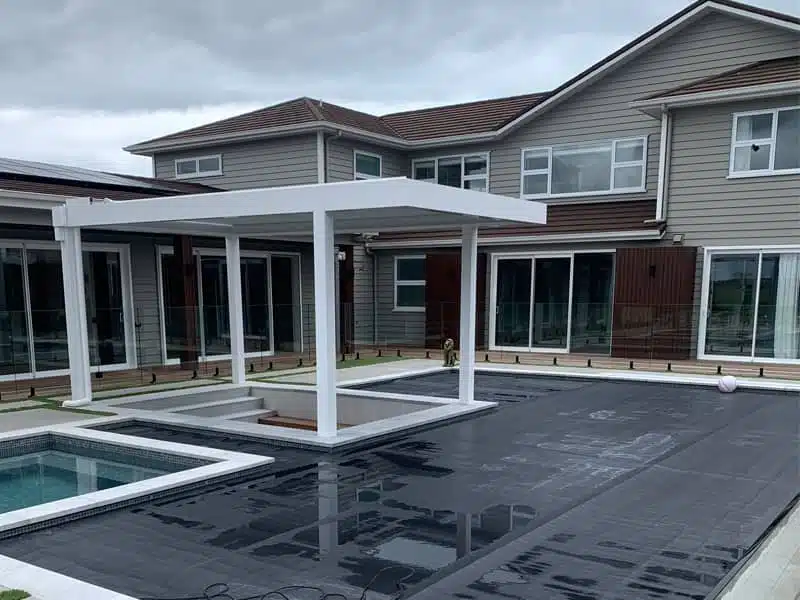
Are you feeling cramped in your Franklin home but don’t fancy moving? Ragrenos’ guide to home extensions offers practical solutions to maximise your living space and boost your property’s value.
Extending your homes in New Zealand is a smart way to grow your house without the hassle of relocating. Whether you’re dreaming of a spacious kitchen, an extra bedroom, or a home office, this guide will set you on the right path.
From single-story additions to multi-level extensions, we’ll explore options that suit various needs and budgets. You’ll learn how to maneuver through local regulations, work with the right tradies, and make informed choices every step of the way.
Extending your home is more than just adding space—it’s about creating the ideal living environment for your family. With careful planning and expert guidance, you can transform your current house into the home of your dreams.
Ready to start your home extension? Let’s dive in and explore how you can make the most of your Franklin property.
Benefits of Extending vs Moving
Home extensions address the common dilemma of a homeowner who is thinking about getting more space but is not keen on moving. It offers a way to grow your living space without leaving the area you love, and it comes with some solid benefits over buying a new place. Let’s look at why extending might be your best bet:
Save money: Avoid real estate fees, legal costs, and stamp duty.
Less hassle: No need to pack up and shift your whole life.
Keep your roots: Stay in your familiar neighbourhood and schools.
Custom fit: Add exactly what you need - extra bedroom, office, or bigger kitchen.
Modernise: Update your home while adding space.
Better value: Often cheaper than buying a bigger house, and can boost your property's worth.
Invest wisely: Put money into a property you already own.
By extending, you can create the perfect home for your family without leaving the area you love. It’s a practical way to get more space and potentially increase your home’s value at the same time.
Importance of Careful Planning
Before you start knocking down walls or calling builders, it’s crucial to have a solid plan for your home extension. Good planning sets the foundation for a smooth project and helps you avoid costly mistakes.
Here’s what you need to consider when planning your extension:
A
Set clear goals: Decide what you want from your extension - more space, a new kitchen, or a home office?
A
Budget wisely: Be realistic about costs and include extra for surprises.
A
Check local rules: Make sure your plans follow Franklin's building regulations.
A
Think long-term: Consider how the extension will affect your home's value and suit your future needs.
A
Get expert advice: Talk to architects, builders, and real estate pros early on.
Taking time to plan carefully can save you headaches and money down the track. It’s worth getting it right from the start to ensure your extension meets your needs and adds value to your home.
Reasons for Extending Your Home
Extending your home is a smart way to improve your living situation without the hassle of moving. Whether you need more space, want to boost your property’s value, or need to adapt to life changes, an extension can be the answer.
Here are the main reasons to consider extending your home:
A growing family or new hobbies often mean you need extra room. Extending your home lets you create the space you need without leaving your current location. Here’s how added space can help:
Add rooms for growing families (e.g., a new nursery for your newborn)
Create areas for new activities (e.g., a home office for remote work)
Reduce cramped feelings and clutter (e.g., a larger living room for family gatherings)
An extension isn’t just about size—it’s about making your home work better for you. You can redesign your layout to suit your lifestyle and add modern features. Consider these improvements:
R
Improve home layout and flow (e.g., opening up the kitchen to the dining area)
R
Add modern features (e.g., an ensuite bathroom to your master bedroom)
R
Create multipurpose areas (e.g., a combined laundry and mud room)
3. Increase Property Value
A well-planned extension can significantly boost your home’s market value. It’s an investment in your property that can pay off when it’s time to sell. Here’s how an extension can add value:
Add square metres to boost market price (e.g., extending the living area by 20 sqm)
Modernise key areas like kitchens and bathrooms (e.g., adding a kitchen island)
Create outdoor living spaces (e.g., building a covered deck for year-round use)
4. Adapt to Changing Needs
Life changes, and your home should too. An extension allows you to modify your space to fit your current situation, whether it’s a growing family or new work arrangements. Here’s how you can adapt:
R
Accommodate family changes (e.g., adding a granny flat for elderly parents)
R
Support new hobbies or work situations (e.g., building a sound-proofed music room)
R
Make the home more accessible as you age (e.g., adding a ground-floor bedroom)
Extending your home can be more cost-effective than moving to a new property. You’ll save on various expenses associated with buying and selling. Here’s what you can avoid:
Save on agent fees, moving expenses, and stamp duty (e.g., avoiding the 5-6% in real estate commissions)
Stay in your familiar neighbourhood (e.g., keeping kids in their current schools)
By extending your home, you’re creating a space that truly fits your lifestyle and needs. It’s a practical solution that can save you money in the long run and increase your property’s value. Plus, you get to stay in the neighbourhood you love, keeping your local connections and avoiding the stress of a big move. Whether it’s adding a new bedroom, creating a home office, or building that dream kitchen, an extension can transform your current house into your ideal home for years to come.
When it comes to expanding your home, there’s no one-size-fits-all solution. Different types of extensions offer various benefits, allowing you to tailor the addition to your specific needs and property. Whether you’re looking to add more living space, create a home office, or simply bring more light into your home, there’s an extension type that can help. Understanding these options is crucial for making an informed decision about how to grow your living space.
1. Single-Storey Extensions
Single-storey extensions are a popular choice for many homeowners. They add valuable space to your ground floor without the complexity of building upwards. These extensions can dramatically change how you use your home, creating larger, more open living areas. Here are the main types:
R
Rear extensions: Ideal for larger kitchens or living rooms
R
Side extensions: Good for using narrow spaces beside your house
R
Wraparound extensions: Combine rear and side for maximum space
2. Multi-Storey Extensions
If you need more space but have a smaller section, going up might be the answer. Multi-storey extensions add rooms on two or more levels, giving you significant extra space without eating up your entire yard. They’re particularly useful for growing families or those who need separate living areas. Consider these options:
Adding bedrooms and bathrooms
Creating a master suite
Loft conversions to use attic space
For those wanting to bring the outdoors in, glazed extensions are an excellent choice. These light-filled spaces create a seamless connection between your home and garden, perfect for enjoying views year-round. They’re also great for adding value to your home. Popular types include:
R
Sunrooms: Modern, bright spaces for year-round use
R
Conservatories: Traditional glass structures, great for plants
Sometimes, a standard extension just won’t cut it. Custom designs allow you to create a space that’s perfectly tailored to your needs and lifestyle. These bespoke extensions can incorporate unique features that standard designs might not offer. Some ideas include:
Home offices with built-in storage
Entertainment areas with indoor-outdoor flow
Specialty rooms (e.g., art studios, home gyms)
When choosing an extension type, consider your budget, section size, and council regulations. Think about how you’ll use the space and how it fits with your existing home. A good builder or architect can help you decide what’s best for your situation.
Remember, any extension should add value to your home and improve your living space. Take time to plan carefully and get the right approvals before you start. With the right extension, you can transform your curre
Planning and Design Process
Extending your home is an exciting project, but it requires careful planning and thoughtful design. This process helps ensure your new space meets your needs, complies with local regulations, and stays within your budget. A well-planned extension can transform your home, adding value and improving your quality of life. By following a structured approach, you can navigate the complexities of home extension with confidence. Here’s an overview of the key steps in the planning and design process:
Assessing Your Needs and Wants
Before you start sketching ideas or calling builders, take time to reflect on what you really need from your extension. This step is crucial for creating a space that truly works for you and your family. Think about how your lifestyle might change in the coming years and how your extension can accommodate those changes. Consider these key questions:
\
What space do you need most? (e.g., bigger kitchen, extra bedroom)
\
How will you use the new area?
\
Are there any eco-friendly features you want to include?
While it’s tempting to do it alone, working with professionals can save you time, money, and stress in the long run. Architects and designers bring valuable expertise in design, planning, and building regulations. They can help you avoid common pitfalls and create a design that maximizes your space and budget. When selecting a professional, keep these points in mind:
\
Look for experience with similar projects
\
Discuss your ideas and budget
\
Ask about their approach to council approvals
Considering Design Elements
Good design is about more than just aesthetics – it’s about creating a space that functions well and enhances your daily life. Your extension should complement your existing home while meeting your new needs. As you work on the design, think about these factors:
\
How the extension will match your existing home
\
Creating a good flow between old and new spaces
\
Making rooms multi-functional if possible
\
Bringing in natural light
Obtaining Necessary Approvals
In New Zealand, most home extensions require council approval. Navigating this process can be complex, but it’s essential for ensuring your project is legal and safe. Understanding the requirements early can help you avoid delays and extra costs later. The approval process typically involves these steps:
\
Checking if you need a building consent
\
Preparing and submitting plans
\
Waiting for council feedback or approval
\
Making changes if required
Remember, good planning can save time and money later. Take your time with this stage and don’t rush decisions. If you’re unsure about anything, ask your architect or builder for advice. With careful planning and design, you can create an extension that not only meets your needs but also adds value to your home for years to come.
Legal and Regulatory Requirements
When extending your home, you need to follow various legal and regulatory requirements. These rules ensure your project is safe, compliant, and doesn’t negatively impact your neighbours. Here’s what you need to know:
Understanding Council Consent
Council consent is a crucial first step in your home extension project. It ensures your plans comply with local regulations and standards. The type of consent you need depends on the nature and scale of your extension. Here are the main types of consent you might require:
\
Building Consent: For structural changes. This covers any work that affects the structure of your home, including adding rooms or altering load-bearing walls.
\
Resource consent: For projects affecting the environment or exceeding certain limits. You might need this if your extension impacts protected trees, changes land contours, or exceeds height or boundary restrictions.
Check your local council’s website for specific requirements in your area. It’s often helpful to schedule a pre-application meeting with a council planner to discuss your project. They can provide valuable insights and help you navigate the consent process more smoothly.
Navigating Building Regulations
Building regulations set the standards for construction in New Zealand. They cover everything from structural integrity to energy efficiency. Understanding these regulations is essential to ensure your extension is safe, durable, and compliant. Key areas covered by the New Zealand Building Code include:
\
Structural integrity: This ensures your extension can withstand environmental forces and remain stable over time.
\
Fire safety: Regulations cover fire resistance, means of escape, and fire alarm systems.
\
Energy efficiency: This includes insulation standards and requirements for heating and cooling systems.
\
Plumbing and electrical compliance: These regulations ensure safe and efficient water and power systems in your extension.
Work with a licensed builder who understands these regulations. They can help interpret the code requirements for your specific project and ensure compliance throughout the construction process. Consider engaging a building inspector early on to review your plans and provide guidance on meeting all necessary standards.
Considering Neighbour Impacts
Your extension plans can significantly affect your neighbours, so it’s important to consider their perspective. Good neighbourly relations can make the process smoother and prevent potential disputes. When planning your extension, think about these factors:
\
Privacy: Consider how your extension might overlook neighbouring properties and plan window placements accordingly.
\
Sunlight and views: Ensure your extension doesn't unreasonably block sunlight or views from neighbouring properties.
\
Noise during construction: Plan construction times to minimize disturbance and keep neighbours informed of the schedule.
\
Boundary issues: Be clear about property boundaries and any shared walls or fences that might be affected.
It’s a good idea to discuss your plans with neighbours early on. This open communication can help address concerns before they become issues and may even lead to helpful suggestions. Consider inviting neighbours to view your plans and listen to their feedback. Remember, a little courtesy goes a long way in maintaining good relationships throughout the construction process.
Legal experts can provide valuable guidance throughout your extension project. They can help you navigate complex regulations, review contracts, and resolve any issues that arise. A property lawyer can assist you with:
\
Understanding zoning laws and property restrictions: They can interpret local zoning regulations on your property title.
\
Reviewing contracts with builders and architects: This ensures your interests are protected and all terms are fair and clear.
\
Handling any disputes that might arise: If issues occur with neighbours or contractors, a lawyer can help mediate or represent your interests.
Consider getting legal advice early in the planning process. This proactive approach can help you avoid potential pitfalls and ensure your project proceeds smoothly. A lawyer can also help you understand your rights and obligations as a property owner, which is particularly valuable if you’re new to home extensions or renovations.
Budgeting and Cost Factors
Understanding the financial aspects of your home extension is crucial for a successful project. A well-planned budget can help you avoid unexpected costs and ensure your extension adds value to your home. It’s important to consider not just the immediate construction costs, but also long-term impacts on your finances. Here’s what you need to know about managing the financial side of your home extension:
Estimating Extension Costs
Accurate cost estimation is the foundation of your extension budget. It helps you determine what you can afford and prevents nasty surprises down the line. Consider these key factors when estimating costs:
\
Size and complexity of the extension: Larger or more complex extensions will naturally cost more. Consider how the design impacts cost.
\
Materials and finishes: Higher-quality materials will increase costs but may offer better long-term value.
\
Labour costs in your area: These can vary significantly depending on your location and the current demand for builders.
\
Council fees and permits: These are often overlooked but can add up quickly.
\
Potential unforeseen issues: Old houses often hide surprises that can impact your budget.
Get detailed quotes from builders to get a realistic estimate. Don’t forget to add 10-20% for unexpected costs. This buffer can help you handle surprises without derailing your project.
Obtaining Multiple Quotes
Getting multiple quotes helps you understand market rates and find the best value. It’s about more than just finding the lowest price – it can highlight differences in approach or materials between builders. When getting quotes:
\
Aim for at least three quotes from reputable builders: This gives you a good range to compare.
\
Provide detailed project information to each builder: This ensures you're comparing like with like.
\
Compare quotes carefully, looking at costs, materials, and timelines: The cheapest quote might not include everything you need.
\
Don't automatically choose the cheapest option: Consider the builder's reputation and experience too.
Remember, the cheapest quote isn’t always the best value in the long run. A more expensive builder might offer better quality work or materials that could save you money on maintenance in the future.
Accounting for Hidden Costs
Hidden costs can quickly blow out your budget if you’re not prepared. These are expenses that aren’t directly related to construction but are necessary for completing your project. Be prepared for costs beyond the basic construction:
\
Architectural and engineering fees: Professional design services can improve your result but add to your costs.
\
Increases in rates and insurance: Your home's increased value may affect these ongoing costs.
\
New furniture and landscaping: You might need these to complete your new space.
\
Temporary accommodation if you need to move out: This can be a significant expense for major renovations.
Factor these into your budget to avoid surprises later. It’s also worth considering how your extension might impact ongoing costs like heating and cooling.
Financing Options and Considerations
Choosing the right financing option can make a big difference to the overall cost of your extension. It’s important to consider not just the immediate affordability but also the long-term impact on your finances. There are several ways to finance your extension:
\
Home equity loans or lines of credit: These use your home as security and often offer lower interest rates.
\
Refinancing your mortgage: This can be a good option if you can get a better interest rate.
\
Construction loans: These are designed specifically for renovations and new builds.
\
Personal loans or credit cards for smaller projects: These can be quicker to arrange but usually have higher interest rates.
Compare interest rates, terms, and fees carefully. Consider talking to a financial advisor to find the best option for your situation. They can help you understand how different financing options might impact your long-term financial goals.
Selecting the right builder is crucial for your home extension project. A skilled and reliable builder can turn your vision into reality, while a poor choice can lead to stress, delays, and unexpected costs. The following steps will help you find and choose a builder who can deliver quality work on time and within budget:
Researching Potential Builders
The first step in finding the right builder is to create a comprehensive list of potential candidates. This research phase helps you identify builders with a good reputation and relevant experience. Cast a wide net to ensure you have plenty of options to choose from. Consider these sources when compiling your list:
\
Recommendations from friends and family: Personal experiences can provide valuable insights into a builder's work ethic and quality.
\
Online reviews and ratings: Websites like BuilderCritic or HomeAdvisor can offer a broader perspective on builders' reputations.
\
Local building associations: These organizations often have directories of reputable builders in your area.
Look for builders with experience in projects similar to yours. This increases the likelihood that they’ll understand your specific needs and challenges.
Checking Credentials and Past Work
Once you have a shortlist of potential builders, it’s time to dig deeper into their backgrounds. This step helps you verify their qualifications and the quality of their work. It’s an essential part of ensuring you’re dealing with a reputable professional. Here’s what to check:
\
Verify their licence and insurance: Contact the Licensed Building Practitioners Board to confirm their credentials.
\
Check for complaints or legal issues: The Disputes Tribunal or your local council may have records of any significant problems.
\
Review their portfolio of past projects: Look for extensions similar to what you're planning.
\
Contact references from previous clients: Ask about the builder's reliability, quality of work, and ability to stick to timelines and budgets.
This thorough vetting process can help you avoid potential issues down the line. Don’t hesitate to ask builders for additional information if needed.
Interviewing and Vetting Builders
After narrowing down your list, it’s time to meet with your top choices. These face-to-face meetings allow you to assess their communication style and get a feel for how well you might work together. It’s also an opportunity to discuss your project in detail. During these interviews:
\
Ask about their experience and approach: Inquire about similar projects they've completed and how they handle challenges.
\
Discuss timelines and cost estimates: Get a sense of how long the project might take and what it might cost.
\
Inquire about how they handle challenges: Ask for examples of how they've dealt with unexpected issues in past projects.
\
Assess their communication style: Consider how well they listen to your ideas and explain their processes.
Choose a builder who understands your vision and communicates well. Remember, you’ll be working closely with this person for several weeks or months, so it’s important that you feel comfortable with them.
Choose a builder who understands your vision and communicates well. Remember, you’ll be working closely with this person for several weeks or months, so it’s important that you feel comfortable with them.
\
Clearly define the project scope and timeline: Be specific about what work will be done and when it should be completed.
\
Get a detailed breakdown of costs: This should include labor, materials, and any potential additional fees.
\
Agree on payment terms: Decide on the deposit amount and when progress payments will be made.
\
Include clauses for changes and dispute resolution: This helps manage unexpected issues that might arise during the project.
Consider having a lawyer review the contract before signing. This extra step can provide peace of mind and help you understand any complex terms or conditions.
Remember, choosing the right builder can make or break your project. Take your time with this process to ensure a smooth and successful home extension. A good builder will not only deliver quality work but also make the entire process less stressful for you.
The construction phase is when your home extension plans become reality. This exciting stage brings its own set of challenges and responsibilities. Proper management during this phase is crucial to ensure your project stays on track and meets your expectations. Here’s how to navigate the construction process effectively:
Before the builders arrive, you need to get your property ready for the work ahead. Proper preparation can help prevent damage to your belongings and ensure a smooth start to the project. Here’s what you should do:
\
Clearing the construction area: Remove furniture and personal items from the work zone. This protects your belongings and gives builders space to work.
\
Protecting your belongings from dust and damage: Cover items with dust sheets or move them to a safe storage area. Seal off doorways to contain dust.
\
Setting up access for builders and materials: Ensure there's a clear path for workers and deliveries. Designate an area for material storage and waste disposal.
\
Informing neighbours about the upcoming work: Let them know about potential noise or disruptions. This helps maintain good relationships during the project.
Communicating with Builders
Clear communication is key to a successful project. Establishing good communication practices from the start can prevent misunderstandings and keep everyone on the same page. Here’s how to maintain effective communication:
\
Establish a main point of contact: Choose one person (either you or your builder) to be the primary communicator. This helps avoid conflicting instructions.
\
Set up regular progress meetings: Schedule weekly or bi-weekly meetings to discuss progress, issues, and upcoming work.
\
Use a shared platform for updates and documents: A group chat or project management app can keep everyone informed and provide a record of decisions.
\
Address any issues promptly: Don't let small problems grow into big ones. Discuss concerns as soon as they arise.
Monitoring Progress and Quality
Staying involved in your project helps ensure the work meets your expectations. Regular monitoring can catch issues early when they’re easier to fix. Here’s how to keep an eye on your project:
\
Schedule regular site visits: Visit the site at least weekly to see progress firsthand. This also shows your builder that you're engaged with the project.
\
Keep a log of progress and discussions: Write down what you see and any decisions made. This record can be valuable if disagreements arise later.
\
Check the quality of materials and workmanship: Make sure the materials being used match what was agreed in the contract. Look for signs of good workmanship like straight lines and neat finishes.
\
Review the timeline regularly: Compare actual progress to the planned schedule. If things are falling behind, discuss how to catch up.
Don’t hesitate to speak up if something doesn’t look right. It’s better to address issues early than to try and fix them after the work is complete. Remember, you’re the client, and it’s your right to ensure the work meets the agreed standards.
Dealing with Potential Challenges
Don’t hesitate to speak up if something doesn’t look right. It’s better to address issues early than to try and fix them after the work is complete. Remember, you’re the client, and it’s your right to ensure the work meets the agreed standards.
\
Unexpected delays: Weather, material shortages, or unforeseen issues can cause delays. Have a plan for how you'll manage if the project takes longer than expected.
\
Budget overruns: Unexpected costs can arise during construction. Set aside a contingency fund of about 10-15% of your total budget to cover these.
\
Unforeseen structural problems: Old houses can hide surprises behind walls or under floors. Be prepared to work with your builder to find solutions if issues are discovered.
Remember, challenges are normal in construction projects. Stay patient and work closely with your team to overcome any obstacles. With good management, you’ll soon be enjoying your new home extension.
As your home extension nears completion, there are a few final steps to ensure everything is perfect. This stage is crucial for turning your vision into reality and making sure your new space is safe, legal, and ready to use. It’s also your last chance to address any issues and add those personal touches that will make your extension feel like home. Here’s what you need to focus on in these final stages:
Final Inspections and Approvals
Before you can use your new space, it needs to pass official inspections. These checks are designed to ensure your extension meets all building codes and safety standards. While the inspection process might seem daunting, it’s an important step in protecting your investment and ensuring your family’s safety. Here’s what you need to do:
\
Contact your local council to arrange final inspections
\
Prepare all necessary documentation (permits, plans, etc.)
\
Be present during inspections to address any questions
\
Obtain the code compliance certificate once all inspections are passed
This process ensures your extension is safe and legally compliant. Don’t be discouraged if the inspector finds minor issues – it’s common and usually easily resolved. Once you receive your code compliance certificate, you can rest easy knowing your extension meets all necessary standards.
It’s normal to have a few last-minute problems as your project wraps up. These could range from minor cosmetic issues to more significant concerns about functionality. Addressing these promptly is key to ensuring your satisfaction with the final result. Here’s how to handle them:
\
Make a list of any issues you notice
\
Discuss these with your builder
\
Agree on solutions and timelines for fixes
\
Follow up to ensure all issues are resolved
Addressing problems promptly ensures your extension meets your expectations. Remember, a good builder will want you to be happy with the final result, so don’t hesitate to speak up about any concerns. Keep communication open and positive, and most issues can be resolved quickly and satisfactorily.
Decorating and Furnishing
Now comes the fun part – making the space your own. This is where your extension truly becomes part of your home, reflecting your personal style and meeting your family’s needs. Take your time with this stage to create a space that you’ll love for years to come. Here’s what to consider:
\
Choose a colour scheme that complements your home
\
Plan your furniture layout before buying anything
\
Consider storage needs to keep the space tidy
\
Add personal touches with artwork or family photos
Take your time with this step to create a space you’ll love. Remember that you don’t have to do everything at once – it’s okay to live in the space for a while and add to it gradually as you figure out how you use it. The most important thing is that it meets your needs and feels like part of your home.
Remember, these final steps are crucial for ensuring your extension is safe, functional, and beautiful. Don’t rush through them. Once everything is complete, take a moment to enjoy your newly expanded home – you’ve earned it! Reflect on the journey you’ve been through and celebrate the new possibilities this space offers for you and your family. Your home extension is not just an addition to your house, but an improvement to your lifestyle.
Frequently Asked Questions
How Long Does a Typical Home Extension Project Take in Franklin?
A typical home extension in Franklin takes 3-6 months, depending on the project’s complexity. This includes 1-2 months for planning and 2-4 months for construction.
Can I Live in My Home During the Extension Construction?
Yes, you can live in your home during construction, but expect noise and dust. Good communication with your builder can help minimize disruptions.
What Are Common Pitfalls to Avoid When Extending a Home?
Common pitfalls include underestimating costs, neglecting permits, and choosing the wrong contractor. It’s also important to consider structural integrity and zoning laws.
How Do Home Extensions Affect Property Taxes in Franklin?
Home extensions typically increase property taxes in Franklin due to the added value. Check with local authorities for specific rates and potential exemptions before starting your project.
What is the difference between home extension and home addition?
While often used interchangeably, home extensions typically expand existing rooms, while additions create entirely new spaces. Extensions are usually more integrated with the current structure, whereas additions can be more distinct.
As we wrap up this comprehensive guide to home extensions, it’s clear that expanding your living space is a journey filled with both challenges and rewards. From the initial planning stages through to the final decorating touches, each step requires careful consideration and informed decision-making. Remember, a successful home extension not only adds value to your property but also enhances your daily life, providing the extra space and functionality your family needs.
At Rag Reno’s, we understand that home extension projects can feel overwhelming. That’s why we’re here to support you every step of the way. Our team of experienced professionals can help turn your extension dreams into reality, ensuring a smooth process from initial concept to final inspection. We pride ourselves on delivering high-quality workmanship and exceptional customer service. If you’re ready to start your home extension journey, reach out to us for a free consultation. Let’s work together to create the perfect addition to your home.

